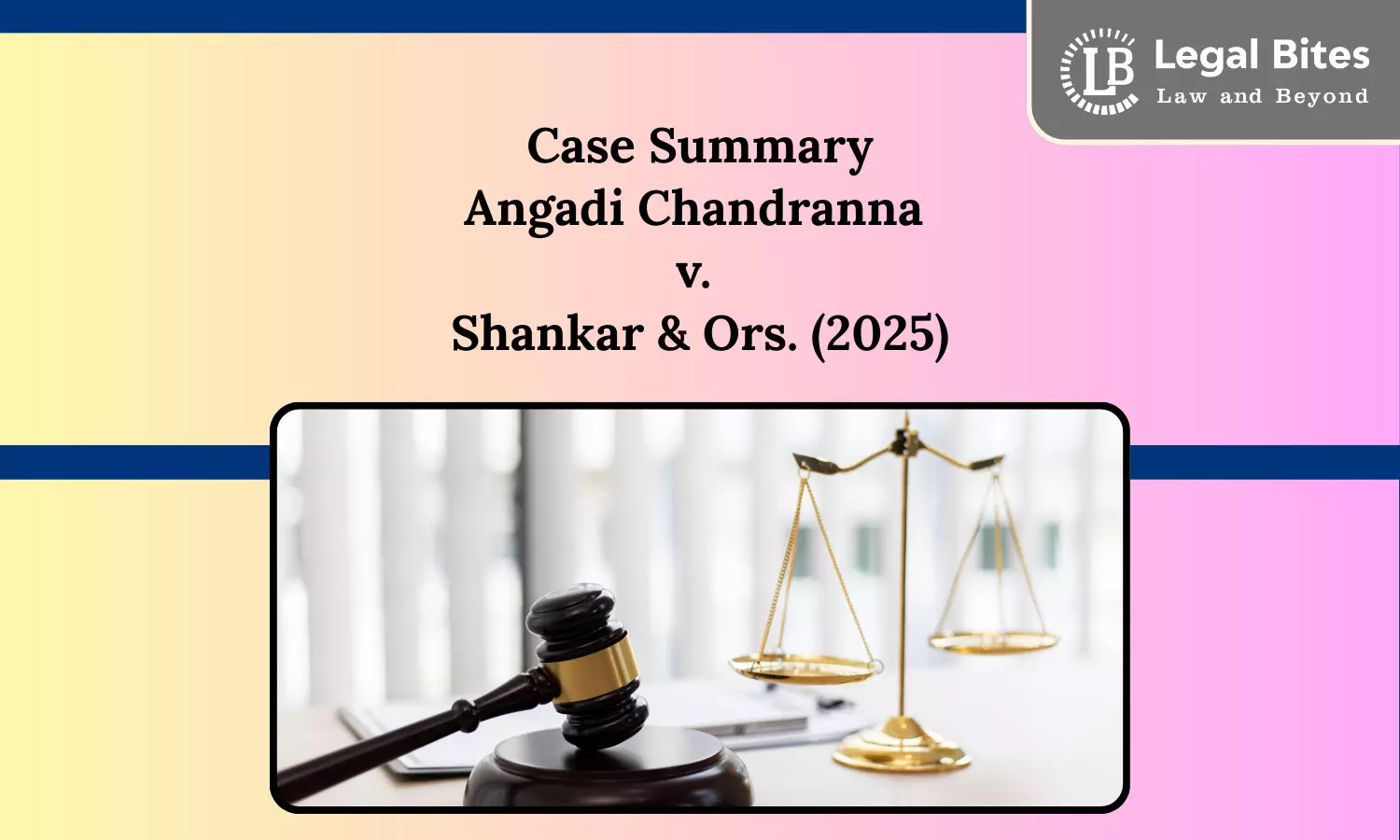Case Summary: Angadi Chandranna v. Shankar & Ors. (2025) | Doctrine of Blending
This case reaffirms key principles on ancestral property, the doctrine of blending, and the evidentiary burden in family property disputes.

The case of Angadi Chandranna v. Shankar & Ors. decided by the Hon’ble Supreme Court of India on April 22, 2025, addresses critical questions under Hindu joint family law and civil appellate jurisdiction. Central to the dispute were the issues of whether the suit property was ancestral or self-acquired, and whether the High Court was justified in reappreciating facts under Section 100 of the Code of Civil Procedure, 1908.
Title of the Case: Angadi Chandranna v. Shankar & Ors
Court: Supreme Court of India
Citation: Civil Appeal No. 5401 of 2025
Decided on: 22nd April 2025
Background and Procedural History
The dispute revolved around property bearing Sy. No. 93, measuring 7 acres and 20 guntas located at Mahadevapura Village, Karnataka. Defendant No. 1 (C. Jayaramappa) had purchased the suit property from his elder brother C. Thippeswamy via a registered sale deed dated 16.10.1989, and subsequently sold it to the appellant (Defendant No. 2 – Angadi Chandranna) on 11.03.1993.
Shankar and other respondents, the children of Defendant No. 1, filed O.S. No. 169/1994 before the Trial Court seeking partition and separate possession, claiming the suit property to be ancestral. The Trial Court decreed the suit in their favour. However, the First Appellate Court (Civil Judge, Senior Division) set aside the decree in favour of Defendant No. 2, holding the property to be self-acquired.
The High Court of Karnataka, in Regular Second Appeal No. 1417/2006, reversed the First Appellate Court's decision and restored the Trial Court’s decree. Aggrieved, the appellant approached the Supreme Court.
Issues Before the Court
- Whether the High Court erred in reappreciating facts under Section 100 CPC?
- Whether the suit property was ancestral property or the self-acquired property of Defendant No.1?
- Whether the doctrine of blending was rightly applied by the High Court?
Appellant’s Arguments (Defendant No. 2)
- The High Court exceeded its jurisdiction under Section 100 CPC by reappreciating factual evidence without framing a substantial question of law.
- Defendant No.1 purchased the suit property using his personal funds and a loan from DW3, thereby making it his self-acquired property.
- The plaintiffs did not seek cancellation of the sale deed, which was mandatory as per Murugan v. Kesava Gounder [(2019) 20 SCC 633].
- The doctrine of blending was incorrectly invoked. As per settled law (Mallesappa v. Mallappa, AIR 1961 SC 1268), intention to abandon separate rights must be clear and explicit.
Respondents’ Arguments (Plaintiffs)
- The suit property was purchased using the joint family nucleus, including income from family lands, coolie work, cash received at partition, and financial help from the grandmother.
- As the plaintiffs were minors during the 1986 partition, they retained coparcenary rights in Defendant No.1’s share, and the purchase using funds derived from that share continued to hold ancestral character.
- Reliance was placed on Yudhishter v. Ashok Kumar [(1987) 1 SCC 204] and Mulla's Hindu Law, asserting that property obtained in partition retains ancestral character with respect to male descendants.
- The sale of the suit property was not made for family necessity but to satisfy Defendant No.1’s personal needs.
Findings and Reasoning of the Supreme Court
1. Scope of Section 100 CPC
The Court strongly criticised the High Court for overstepping its jurisdiction under Section 100 CPC. Citing Jaichand (Dead) Through LRs & Ors. v. Sahnulal & Anr.(2024 SCC OnLine SC 3864) and Hero Vinoth v. Seshammal [(2006) 5 SCC 545], the Court reiterated:
- A second appeal must involve a “substantial question of law”.
- The High Court cannot reappreciate facts unless findings of the lower courts are perverse, based on no evidence, or involve an incorrect legal inference.
- Section 103 CPC permits fact determination only if courts below failed to determine an issue despite available evidence.
The Supreme Court concluded that the High Court’s exercise was a mere re-evaluation of facts, without identifying any substantial question of law, making its interference invalid.
2. Nature of the Suit Property
The key dispute was whether the property purchased by Defendant No.1 was ancestral or self-acquired.
- The partition deed of 1986 allocated different shares to Defendant No.1 and his brothers, including C. Thippeswamy, who later sold the suit property.
- The partition deed explicitly allowed parties to deal with their shares as self-acquired property.
- The plaintiffs failed to prove that Defendant No.1 used joint family income or a nucleus to purchase the suit property.
The Court emphasised that under Hindu law, merely being part of a joint family does not make a property joint. A party claiming ancestral status must prove the existence of a joint family nucleus and that such income was used for acquisition.
The evidence (DW1–DW4) established that Defendant No.1 procured a loan from DW3 and repaid it through a subsequent sale. The plaintiffs failed to prove the contrary with cogent evidence. The Supreme Court accepted that the suit property was purchased using borrowed money, not ancestral funds.
3. Application of the Doctrine of Blending
The Court clarified that the doctrine of blending requires:
- Voluntary intention by a coparcener to convert self-acquired property into joint family property.
- Mere shared enjoyment or generosity does not constitute blending.
Citing Lakkireddi v. Lakshmama [1964 (2) SCR 172] and K.V. Narayanan v. K.V. Ranganandhan [(1977) 1 SCC 244], the Court ruled that no such intention was demonstrated in this case. The plaintiffs failed to produce any proof showing that the property acquired by Defendant No.1 was ever thrown into the common stock.
Conclusion
The Supreme Court held that:
- The High Court erred in re-evaluating the evidence and substituting its view over a plausible finding of the First Appellate Court without framing a substantial question of law.
- The suit property was not ancestral but self-acquired by Defendant No.1 using borrowed funds.
- The doctrine of blending did not apply without clear evidence of abandonment of separate ownership.
Decision
The Hon’ble Supreme Court allowed the appeal and passed the following order:
- The judgment and decree of the High Court dated 12.08.2021 were set aside.
- The judgment and decree of the First Appellate Court dated 21.02.2006 were restored.
- Parties were directed to bear their costs.
Click Here to Read the Official Judgment
Significance of the Judgment
This judgment is significant for several reasons:
- Clarification on Appellate Jurisdiction: It affirms the narrow scope of interference under Section 100 CPC and discourages unwarranted fact-finding in second appeals.
- Reinforcement of Hindu Property Principles: The Court reinforced the principles related to ancestral property, burden of proof for the joint family nucleus, and the doctrine of blending.
- Evidentiary Discipline: The case emphasises that oral assertions must be supported by documentary proof and corroborated evidence, especially in family law property disputes.
- Custom and Necessity: The ruling recognised cultural and legal traditions such as a father’s duty to perform his daughter’s marriage as constituting “legal necessity,” thereby justifying property alienation under Hindu law.
Important Link
Law Library: Notes and Study Material for LLB, LLM, Judiciary, and Entrance Exams

